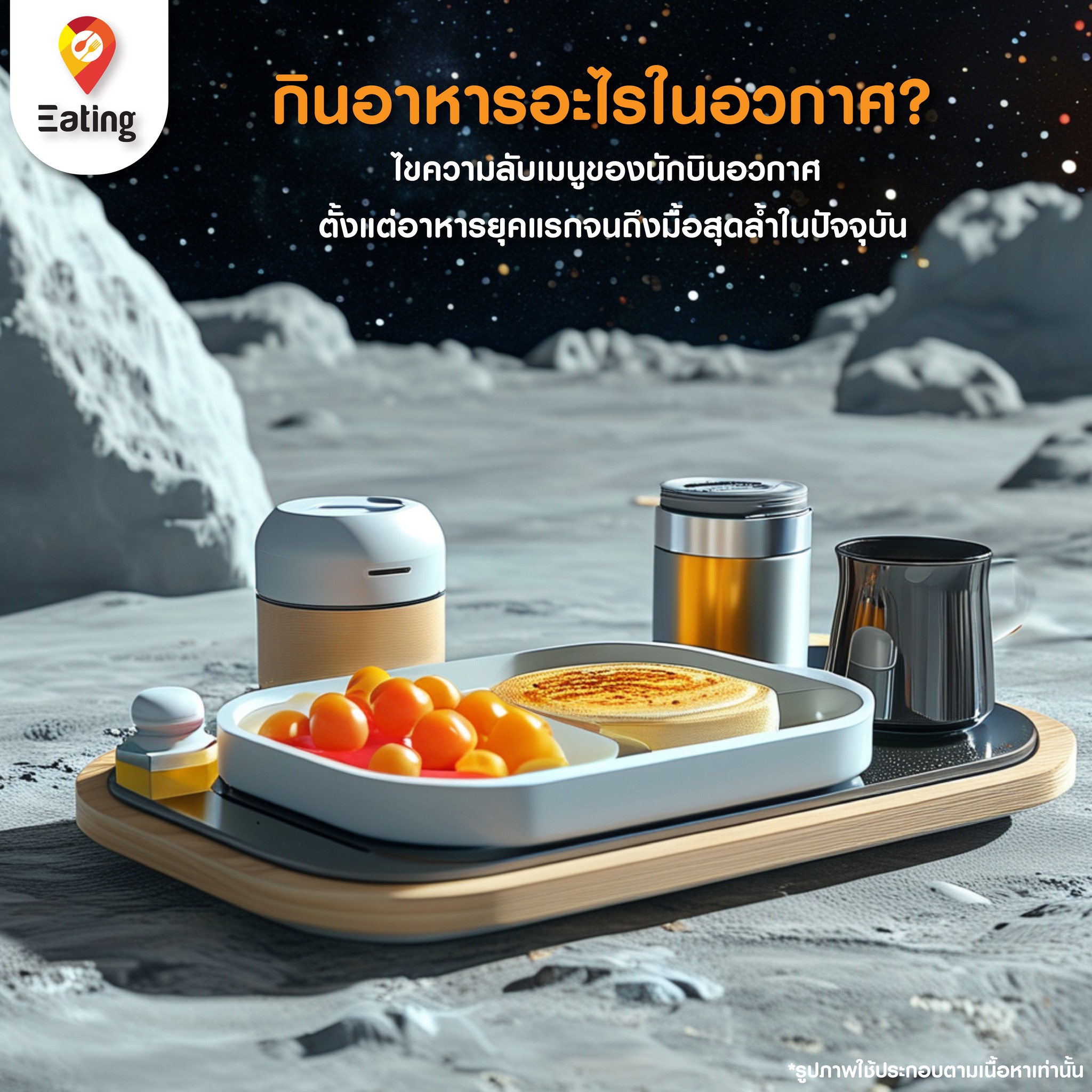Insider
New Experience

กินอาหารอะไรในอวกาศ?
ไขความลับเมนูของนักบินอวกาศ ตั้งแต่อาหารยุคแรกจนถึงมื้อสุดล้ำในปัจจุบัน
อาหารสำหรับนักบินอวกาศ มีการพัฒนามาไกลจากยุคแรกๆ ที่เป็นเพียงอาหารอัดหลอดแบบครีมหรืออาหารแห้งที่ต้องผสมน้ำก่อนกิน ตอนแรกสุด อาหารอวกาศยังไม่มีความหลากหลายมากนัก เพราะต้องออกแบบให้พกพาง่าย มีน้ำหนักเบา และไม่เน่าเสีย
.
อาหารอวกาศชุดแรกของโลกถูกใช้ในยุคของยูริ กาการิน นักบินอวกาศคนแรกของโลกในปี 1961 ซึ่งเป็นอาหารที่ถูกบรรจุในหลอดคล้ายยาสีฟัน นักบินต้องบีบอาหารออกมากิน โดยเมนูที่เขาได้รับมีทั้งซุปเนื้อบดและขนมหวานที่เป็นครีมช็อกโกแลต ต่อมาในยุคอพอลโลของสหรัฐฯ ได้พัฒนาอาหารให้กินง่ายขึ้นโดยเปลี่ยนมาใช้ระบบ "อาหารแช่แข็งแบบฟรีซดราย" ที่สามารถเติมน้ำแล้วกินได้เลย ทำให้อาหารมีรสชาติดีขึ้นและหลากหลายขึ้น
.
ปัจจุบันอาหารของนักบินอวกาศมีความใกล้เคียงกับอาหารบนโลกมากขึ้น เพราะเทคโนโลยีการถนอมอาหารพัฒนาไปมาก มีการใช้กระป๋อง ฟอยล์ หรือถุงสุญญากาศเพื่อรักษาคุณภาพและรสชาติ นอกจากนี้ยังมีการใช้เครื่องปรุงที่ช่วยเพิ่มรสชาติ เพราะในสภาวะไร้น้ำหนัก นักบินอวกาศมักจะรับรสได้ลดลง อาหารจึงต้องมีรสชาติจัดจ้านขึ้น
.
อาหารบางชนิดสามารถกินได้เลย เช่น ถั่ว อาหารกระป๋อง หรือขนมปังแผ่นบาง แต่บางอย่างต้องเติมน้ำร้อนหรือน้ำเย็นก่อน เช่น ซุป พาสต้า หรือข้าว นอกจากนี้ นักบินอวกาศยังสามารถเพาะปลูกพืชในอวกาศได้แล้ว อย่างเช่น ผักกาดหอม มะเขือเทศ และพริก ซึ่งเป็นก้าวสำคัญสำหรับอนาคตของการเดินทางในอวกาศระยะยาว
.
สำหรับเมนูอาหารที่นักบินอวกาศนิยมในปัจจุบันก็มีความหลากหลาย ตั้งแต่สเต๊ก ข้าวแกงกะหรี่ ซุปไก่ บะหมี่ ไปจนถึงของหวานอย่างพุดดิ้งและเค้ก ในสถานีอวกาศนานาชาติ นักบินอวกาศจากหลายประเทศมีโอกาสได้นำอาหารจากวัฒนธรรมของตนขึ้นไปด้วย เช่น อาหารญี่ปุ่นอย่างราเมง หรืออาหารรัสเซียอย่างบอร์ช (ซุปบีทรูท) ทำให้เมนูมีความหลากหลายและช่วยให้พวกเขารู้สึกเหมือนได้กินอาหารบ้านเกิด แม้ว่ายังมีข้อจำกัดเกี่ยวกับอาหารที่มีเศษผงเยอะๆ หรือของเหลวที่อาจลอยไปในอากาศ แต่โดยรวมแล้ว อาหารของนักบินอวกาศในปัจจุบันสามารถทำให้พวกเขามีความสุขและได้รับสารอาหารครบถ้วนมากกว่ายุคแรกๆ อย่างมากเลยทีเดียว
Space food has come a long way from the early days when it was just cream-filled tubes or freeze-dried food that required water to be added before eating. In the beginning, space food wasn’t very diverse because it had to be easy to carry, lightweight, and have a long shelf life.
The first space food in history was used during the era of Yuri Gagarin, the first astronaut in 1961. It came in toothpaste-like tubes, and astronauts had to squeeze it out to eat. The menu included items like ground beef soup and chocolate cream desserts. Later, during the Apollo missions, the food was made easier to eat by using the "freeze-dried" method, which allowed astronauts to just add water and eat right away. This development made the food taste better and more diverse.
Today, space food is much closer to the food we eat on Earth thanks to advancements in food preservation technology. Cans, foil, and vacuum-sealed bags are used to preserve the quality and taste. Additionally, seasonings are used to enhance the flavor since astronauts often experience a reduced sense of taste in weightlessness. Therefore, the food is made to be more flavorful.
Some foods can be eaten directly, such as nuts, canned food, or crackers, while others need to be mixed with hot or cold water first, like soup, pasta, or rice. Furthermore, astronauts can now grow plants in space, such as lettuce, tomatoes, and peppers, marking an important step for the future of long-term space travel.
As for the types of food astronauts enjoy today, they have a wide variety of options, including steak, curry rice, chicken soup, noodles, and even desserts like pudding and cake. On the International Space Station, astronauts from various countries have the opportunity to bring food from their cultures, such as Japanese ramen or Russian borscht (beet soup). This diversity adds variety to their meals and makes them feel closer to home. Although there are still limitations regarding foods with many crumbs or liquids that might float in the air, overall, space food today is much more satisfying and nutritious than in the early days.